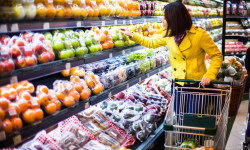GMO-Free vs. Organic: What’s the Difference?

Last week, the U.S. Department of Agriculture (USDA) announced it was developing a verification program for foods containing genetically engineered (GE) ingredients, also known as GMOs. Like the USDA’s existing Process Verified Program that certifies foods as organic, beef as grassfed, and meat as antibiotic-free, the new program would be voluntary and would allow companies to label their foods as “GMO-free.”
That GMO-free label can be worth big bucks to companies. Though the scientific consensus is firmly behind GMOs’ safety, activist groups have whipped up enough fear among consumers that many are looking for opportunities to avoid GMOs at all costs. It’s why one large company asked the USDA “to develop testing and verification processes to verify the non-GE claim” and USDA Secretary Tom Vilsack says “other companies are already lining up to take advantage of this service.”
Currently, companies that want to market their products as “GMO-free” do so through either private labeling programs like the “Non-GMO Project” or simply market their foods as GMO-free without any verification. Before the USDA stepped in to certify foods as organic, a similar patchwork system of questionable labels and verification existed for organic foods and the new USDA GMO-free label would likely make the current private labeling programs obsolete.
All of these different labels and terms have created a lot of confusion among consumers about what GMO-free and organic really mean, and what consumers are actually paying for.
Growing organic food is much more expensive than conventional agriculture–organic farmers pay more for their fertilizer and UDSA Organic-approved herbicides, it often takes manual labor to cut down weeds, and additional planting efforts to capture soil nutrients. It’s why organic foods can cost twice as much as conventionally-grown foods. You can read more about the approved chemicals used in organic farming and what organic means in our blog here.
GMO-free crops, however, aren’t that much different than conventional foods. Farmers use the same fertilizers on both and spray both with pesticides and/or herbicides as needed (though evidence suggests that GMO crops require less pesticides than GMO-free conventionally grown crops). GMO-free crops then sell at a slight premium over the standard commodity price for crops like soybean and corn.
Consumers who (erroneously) think GMO-free means “healthier” are often willing to pay a slight premium for GMO-free products, even when they don’t want to shell out significantly more for organic—a fact that has led to conflict between GMO-free and organic companies.
Though the USDA’s new verification program won’t stop activists from pushing for mandatory GMO labeling on all foods, it will detract from their arguments that consumers don’t have the option to purchase GMO-free foods. Just as consumers can currently choose organic foods if they want to avoid GMOs, the new label will add even more choices for label-conscious shoppers.





